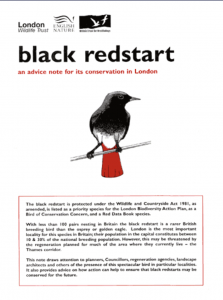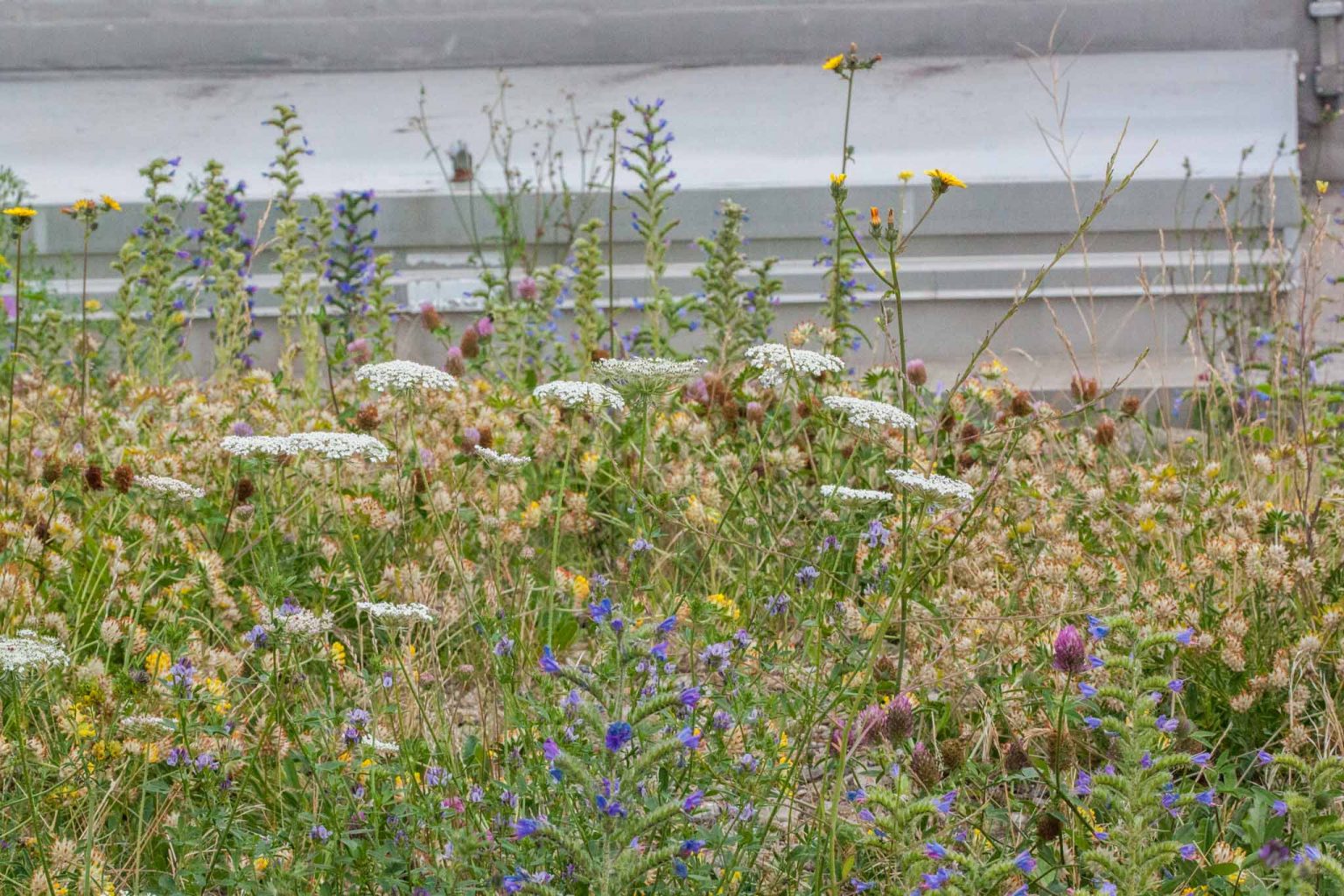The black redstart is synonymous with green roofs for me. Importantly, the story of the black redstart is a story of renewal. It is a story of colonising destroyed and forgotten parts of London. A story of moving on as the approach to urban landscape develops. It is a conservation success story and a story of adaptation and survival.
Contained in this story is the story of how green roofs grew from the margins of the construction industry to become a mainstream roofing activity in the UK capital. It is a story that is not only about keeping nature in our cities but ,also, about how nature can help our cities to adapt to climate change.
Renewal and adaptation are key themes of the inaugural world green roof day. For cities today must renew and adapt in order to combat the vagaries of climate change. And just as green roofs were crucial to the conservation of black redstarts in London, they will be crucial to this wider story of renewal – creating climate resilience.
A potted history of black redstarts in London

Black redstarts first bred in the UK in 1926 at Wembley Arena. However, they really came to prominence during the Second World War. Ironically, the devastation wrought on London by the Blitz created a perfect habitat for the species. There is nothing a black redstart likes more than rubble.
“At least three pairs breed between 1926 and 1941, but their annus mirabilis apparently came in the following year heavily assisted by the German Luftwaffe, which left swathes of the city in ruins – perfect conditions for a rock-hunting species.” – Birds Britannica
The population boomed, especially in the City of London. Black redstarts bred in the shadow of St Paul’s and around where the Barbican stands now. For London birdwatchers in the 1950s, roads such as Milk Street and Beech Street were synonymous with the bird. Yet, in time the City renewed itself. New offices and housing sprouted up from the rubble ruins. As they grew, the black redstart – an elusive bird at the best of times – became more difficult to locate in the city as its favoured habitat slowly disappeared.
During the 1960s and 1970s, London experienced industrial decline. While a few pairs of black redstarts remained in the city, the species moved out to the declining docks and factories to the east. Other industrial sites also became important places for the species to breed, particularly power stations such as Ferranti’s Deptford Power Station. In time, these sites also came up for renewal. In the 1980s, housing and offices replaced the redundant factories and docks, putting the survival of black redstarts at risk yet again.
The black redstart and Deptford Creek
Although the bird was and is a protected species under the Wildlife and Countryside Act 1981, wildlife – and especially bird – organisations ignored its conservation; the bird did not nest on prized nature conservation habitat such as heathlands or forest, marsh or ancient meadow. Its natural habitat simply did not conform to “conventional notions of beauty”:
“The inner city wasteland in which this species thrives completely subverts our conventional notions about beauty in landscapes…uncared for, unmanaged and unintentional – it is, in a way, the nearest thing to true wilderness that we possess. And its bird emblem is the black redstart…” – Mark Cocker, Birds of Britannica

This attitude was about to change, however. In late the late 1990s, I discovered several pairs of black redstarts nesting in Deptford Creek, on the site of the old power station. It was my first professional job as an ornithologist. I was employed by the Creekside Regeneration Board. The discovery brought together a dedicated team of organisations – the Creekside Regeneration Board (whose legacy is the Creekside Centre), the London Wildlife Trust , the Environment Agency, Lewisham Council and individuals who were determined to maintain its conservation. The challenge was how to maintain the black redstart’s habitat without putting the brakes on much-needed housing and regeneration. The answer was to create ‘habitat’ roofs for the species. The idea was simple yet the journey was hard. Developers, architects, and engineers were extremely resistant to the idea and it was a long and hard-fought battle.
But the conservation of the species ultimately succeeded. Where the black redstart once bred on wasteland and rubble, the roofscapes around Milk Street and Bishopsgate in the City, Deptford in south east London, and King’s Cross, now provide ‘open mosaic’ habitats for the bird. These are the inner city wastelands – the “uncared for, unmanaged and unintentional” spaces now created very intentionally on the roof tops of London, not just for the black redstart but for a whole host of species in need of a substitute for their disappearing habitats.

The black redstart and the green roof industry
The story doesn’t end there. The black redstart and the roofs that ensure its survival in London have spawned an industry. The green roof industry has grown from a marginal activity to a mainstream one, not only in London but across the entire UK. This year, the industry has taken a big step forward. The Green Roof Organisation (GRO), of which I am both a founder a board member, is now the official trade body for the industry. World Green Roof Day, founded by Chris Bridgman of Bridgman&Bridgman, is an opportunity for the industry to promote the contribution it makes to increase biodiversity and combat climate change .
This industry will grow. Our industry holds one of the keys to the renewal of our cities, not only in the UK but across the globe. A renewal that is ever more urgent owing to the climate emergency. While issues related to the rise in temperature and frequent flash floods are at the forefront of adapting our cites, we must not forget nature. And let’s not forget the black redstart. Without the black redstart this industry – and what it has to offer to cities – may not have been in the strong position it is now. Perhaps the bird is an appropriate emblem for an industry that will surely only grow.